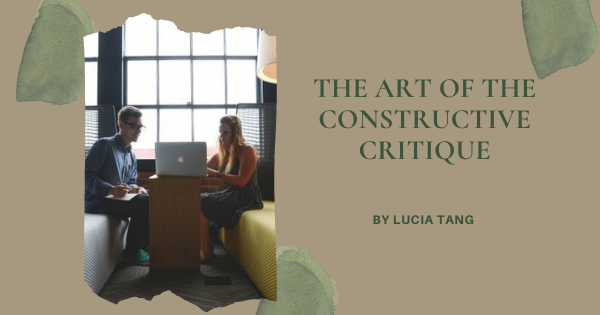by Lucia Tang @Reedsy
Nothing thickens your skin like a writing career. When it comes to fielding acid-tongue critiques, most of us have strategies for calming down and keeping it all in perspective. But what happens when you’re the person having to give the harsh critique?
Offering feedback on a fellow writer’s work-in-progress is a delicate, often emotionally draining task, as challenging in its own way as architecting a plot twist or capturing an elusive character’s voice. Like plotting, critiquing a manuscript requires big-picture thinking and a bird’s-eye view of the story’s overall goals. And like character development, it’s an exercise in empathy — for the writer, and for the readers who will encounter their work in the future.
Penning a thoughtful critique uses some of the same mental muscles as writing a book review or polishing your own draft. But you have to keep in mind that the work is A) not your own and B) still unfinished.
At the end of the day, the constructive critique is a genre all its own, with conventions to follow and an audience to keep in mind. To learn how to master this subtle, challenging form, I spoke to my colleague Jenn Gott, a six-time indie author whose superhero novel snagged a starred review on Publishers Weekly.
Jenn participates in a regular writing group, as well as a critique partnership with a fellow indie author, so offering — and receiving — constructive criticism is a major part of her writing practice. Here are her tips for offering feedback as clearly, graciously, and helpfully as possible.
1. Read the text on two levels — as a professional, and as a fan
Needless to say, examining the draft of a novel with an eye to improving it feels nothing like indulging in a published beach read. It’s like the difference between a chef tasting a soup mid-simmer to check the salt levels, and a diner luxuriating in that same soup after it’s served up with a spring of garnish. Instead of sinking into the story, you have to study it with some distance — taking note of what works and prodding at what doesn’t.
That said, Gott cautions against taking yourself completely out of the readerly point of view. Part of your function as a critique-giver, after all, is to anticipate what later, less-critical consumers of the story will think. “The more polished the draft is”, Gott notes, “the more easily I get swept up in it and forget to be critical. So that’s part of how I tell how much more work it needs.”
To offer a nuanced, well-balanced critique, try reading the text twice. On the first run-through, allow yourself to respond to it as a reader, paying attention to what piques your interest and what ignites your fannish need to know more. Your second pass is when the proverbial red pen can come out. Reading this way will yield you both positive and critical points to incorporate into your feedback. You can then layer these in a criticism “sandwich”, interpersing your “cons” between “pros” to craft a critique that goes down easy.
2. Focus on the writer’s aims
In addition to getting into future readers’ heads, critiquing a manuscript demands empathy for the writer’s point of view as well.
Offering feedback on a colleague’s work is different from revising your own in one key respect: their voice, sensibilities, and overall goals might not align with your own. And while critiquing gives you an opportunity to help fashion their work into its ultimate shape, you have to be careful not to force it into a copy of your style.
For Gott, the key to offering helpful, empathic feedback is working from a solid understanding of the writer’s aims. “Any time I critique,” she says, “it’s really important for me that I’m not turning their work into my work. You want to make sure that your suggestions are bringing the story closer to the author’s vision for it.” Of course, you can’t just assume you get the author’s vision based on what you see on the page — you should ask them directly, giving them an opportunity to articulate what they’re trying to achieve.
But what if they’re trying to achieve something you just can’t wrap your head around — whether they’re promoting a political agenda you don’t agree with, or working with tropes you just can’t see the appeal in? In cases like that, Gott suggests, it might be best to recognize you’ve hit an impasse and pass the work on to someone who’s better positioned to critique it. (It’s good practice, of course, to let the author know why you feel uncomfortable reviewing their work — they may not have a good sense of just whom they’re alienating!)
3. Offer solutions
If you do feel capable of offering a thoughtful, constructive critique, be sure to follow through on it. One thing Gott tends to find frustrating as a recipient of feedback is “drive-by criticism” — cursory notes that aren’t elaborated upon, from a critic who shuts down if you try to ask them questions.
If you don’t want your critique partner to feel like they’ve been left hanging, it’s helpful to make yourself available for a round or two of clarifying Q&A’s. That way, if any part of your feedback is unclear, they don’t have to puzzle it out on their own.
To avoid being bombarded with questions, though, try to offer solutions alongside your criticisms in the first place. If you point out a bit of inconsistent characterization, for instance, work in a comment about how you might expect that character to behave instead. And if you flag a weak verb, list a few more vivid alternatives they might try on for size.
Offering solutions to the problems you pinpoint will make your critiques feel like entry points in a genuinely collaborative relationship — not mean-spirited nitpicking. Even if you never work that manuscript again, you’ll still have helped that writer produce the best work they can. And that’s something both of you can celebrate.
Lucia Tang is a writer with Reedsy, a marketplace that connects self-publishing authors with the world’s best editors, designers, and marketers. Reedsy also provides tools to help authors write and format their books, as well as free courses and webinars on publishing. In Lucia’s spare time, she enjoys drinking cold brew and planning her historical fantasy novel.
Lucia Tang @Reedsy with 3 Tips for Giving Better Critiques: Share on X
Photo on Visual hunt


Thanks for this, Lucia! Critiques are so tricky–the writer asking them wants advice but no one wants to be too critical. These are good tips for a good balance.
Those notes on the side that offer ideas are very helpful. I’d also say point out what does work very well – a little positive boost goes a long way.
That’s very important–I’ve always said I’m no gatekeeper…it’s important to provide positive direction for other writers.
These are great tips. I can see where it might be difficult for a writer to give direction in what they feel doesn’t work for a story without putting their own style into the mix. The second read from a reader’s viewpoint would be most helpful.
This is such good advice! It’s timely, too. I’ve been working with a young writer who has some strong and interesting ideas, etc., and has asked me to serve as a sort of coach. It’s good to be reminded of useful ways to offer input that tell the truth, but are supportive.
You’ll be a wonderful coach and mentor, Margot!
Thanks for the great tips, Lucia. I never thought to read a manuscript I’m critiquing on two levels. I will keep it in mind when I critique my critique partners’ submissions in the future.
Thanks for coming by, Natalie!
That’s why I tell my authors, even after our editor goes through their work, that they know their story and their vision best and always stick with gut instincts.
It’s true–especially since different betas will often have different opinions and ideas for changes.
Great tips. I’m happy to hear critiques of my work as long as the person I’m talking to has thoughts on how to make it better.
I think reading as a fan and as a fellow writer are important, but I think one test is to see which is easier to do on your first pass. In other words, if the story doesn’t organically absorb me, that’s something the writer I’m critiquing should probably be aware of.
That’s such an important point. If the pace is off, if the characters aren’t interesting, if the story doesn’t grab you, that’s something for writers to know about.
Great advice to help focus. Sometimes, it’s hard to know where to start and where to end when looking over someone else’s work. Also a good point to offer solution in another way than rewriting problem sections.
I thought it was helpful, too. Thanks for coming by, Tina!